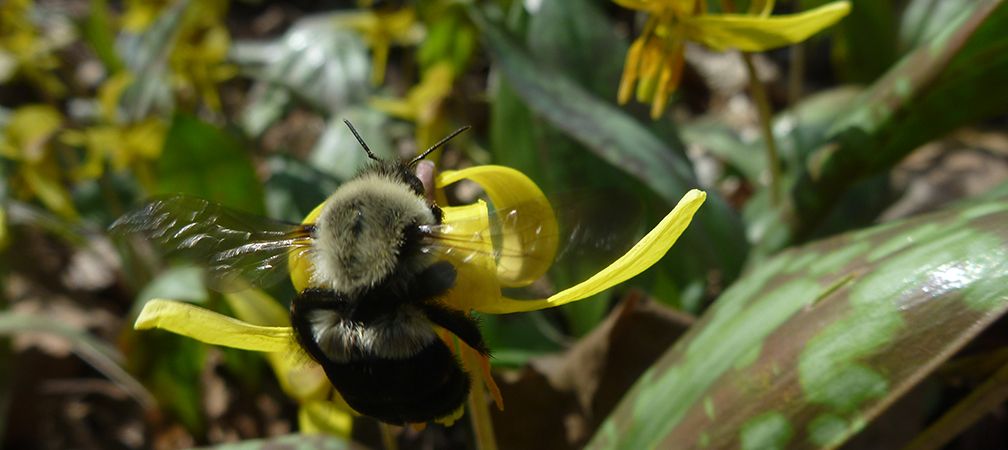Ontario Nature Blog
Receive email alerts about breaking conservation
and environmental news.
© Lora Denis
Bumble bees are important pollinators in Ontario, but it is estimated that one third of them are in decline. We need more information to better conserve them, and researchers are turning to community science to complement traditional scientific methods. Programs such as Bumble Bee Watch (BBW) are already making a huge difference by filling knowledge gaps, supporting conservation status assessments, increasing public awareness, and more.

Community scientists are members of the public who contribute to scientific research projects. BBW participants take photos of bumble bees across Canada and the United States and submit them through www.BumbleBeeWatch.org or the free Android or iOS apps. The submitted files are then identified by experts. All that is needed along with participants’ photos is the date, location, and optionally, the flower visited. While most people participate independently, there are formal volunteer surveys in some regions, such as Pinery Provincial Park.
BBW was launched in 2014 to track and conserve North America’s bumble bees. Currently administered by The Xerces Society for Invertebrate Conservation, Wildlife Preservation Canada, and York University, BBW has now received over 101,000 records. For my PhD, I posed the question: can community science programs, and BBW in particular, be used for conservation? The resounding answer was YES!

BBW has contributed important information to conservation science. For example, it increased our knowledge as compared to the Bumble Bees of North America database (BBNA), a database of researcher-collected bumble bee records. BBW recorded 41 species (BBNA had 48) from all parts of the continental US and Canada, confirmed the persistence of species at locations over time, and provided new locations for species (including rare ones!) both outside of and within their known distribution. BBW showed its greatest impact in the 2010-2020 time period by contributing 25% of all combined records, 28% of all unique locations, and 32% new plant forage genera. The few species BBW did not find were either cryptic (hard to identify), potentially extirpated, and/or only found in the high Arctic.

BBW is not meant to replace traditional surveys, but it does complement them; the data can be combined and used in various analyses. For example, the American bumble bee (Bombus pensyvlanicus) can be considered critically endangered in its Canadian range according to a recent paper using IUCN Red List criteria due to a 89% population decline between 1907-2006 and 2007-2016. BBW provided 20% of all the American bumble bee records and 36% of its sites over the 2007-2016 period, contributing important information on its current abundance and distribution.
No experience is required to participate in BBW. Participants can use interactive identification keys to choose features visible on their bee, such as the colour pattern on the abdomen or the presence/absence of a dot or band on the thorax, to narrow down the potential species and assign a name to their bees. On average, participants were accurate about 53% of the time, although some species were frequently mis-identified. For example, of all the photos identified by participants as the yellow bumble bee (B. fervidus), experts asserted the labels corresponded to 32 different species! The reasons for this are varied, but misidentification may happen with species with wide-spread distributions and/or many colors. We are creating more resources such as identification guides with regional atlas projects and an ever-increasing gallery of verified images to help participants, but they already report an increased awareness of species diversity and improvement in their identification skills.

BBW volunteers want to contribute to science, help save the bees, and learn more about species in their area. Does this sound like you? Sign up today at www.BumbleBeeWatch.org, browse the photo galleries, explore the sightings map, and submit your photos from past years. Bumble bee conservation is important for us all to support.

Gananoque Lake Nature Reserve © Smera Sukumar
Hi JoAnne. No, BBW does not contribute records or identifications to iNaturalist or vice versa (although some experts contribute ids to both programs), but both organizations contribute data to North American bumble bee databases. Some researchers are more hesitant to use data from iNaturalist vs BBW as there can be less accuracy with crowd-sourced ids vs expert-only ids, but we’d rather data go to iNaturalist than nowhere at all. Hope that helps!
Does BBW collaborate with iNaturalist for bumblebee identifications, or use each other’s data? I am using iNaturalist. It would be easier and quicker for me to combine the two for observations.
Thank you